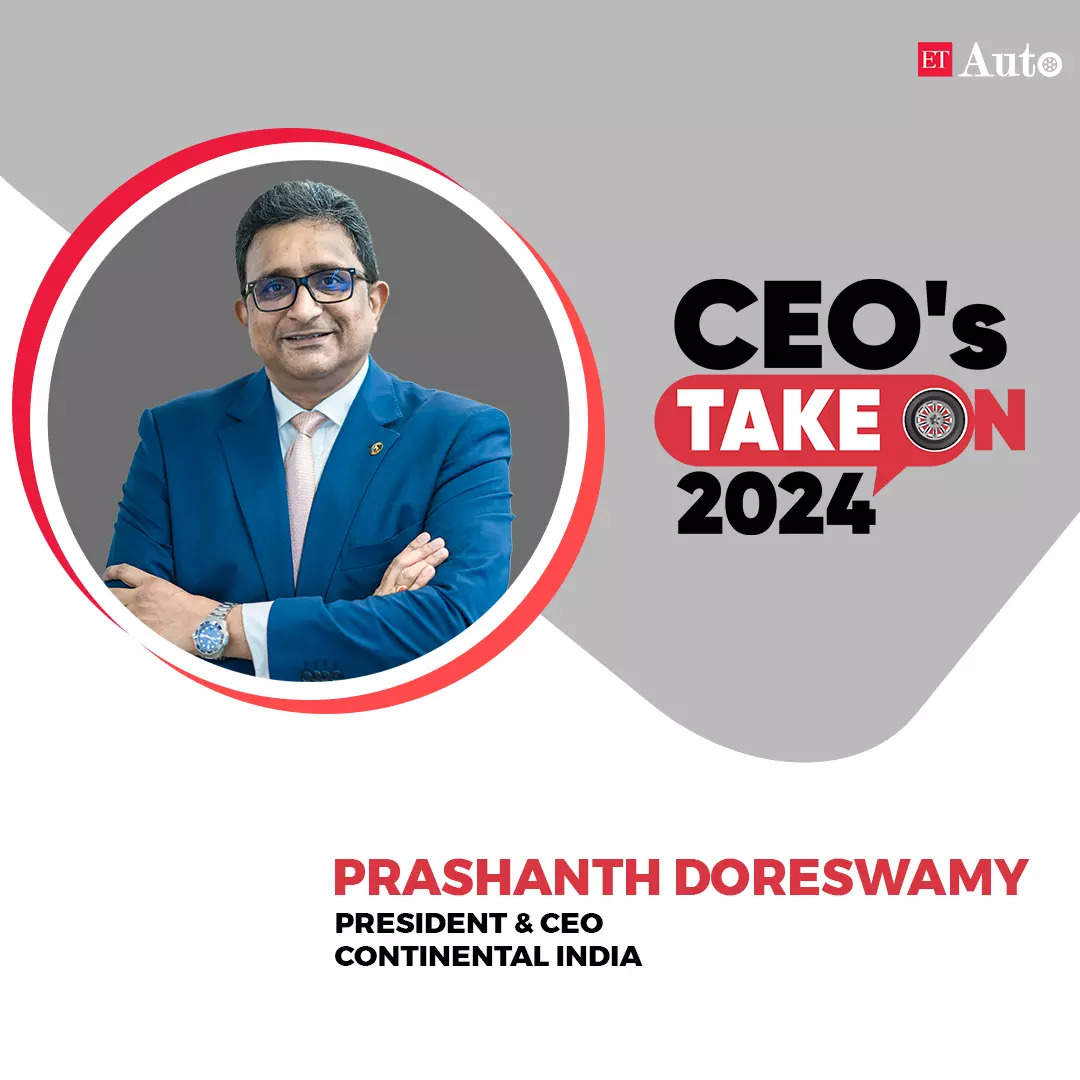
Edited excerpts:
Q. After two consecutive years of swift growth in the auto industry’s performance, what is your outlook for 2024?
Globally, 2023 was a roller-coaster ride, with several challenges, including supply chain disruptions carried forward from the previous year, material cost increase, geo-political tensions, labour unrest in some parts of the world and declining EV sales. 2024 is likely to see the industry stabilize and return to normal. Coming to India, the last two years saw good performance of the industry, be it sales, launch of new models, first-time uptake of new technologies, positive regulations and so on. 2024 is certainly promising, although with its own challenges.
Car buyers will continue to expect new driving experiences and more convenience from technology. Connected features and Driver Assist functions will no longer be seen as luxury. Two-wheelers too will see integration of connected technologies. The integration of software has transformed the vehicle architecture, and we will move further away from a hardware-centric approach. Overall, the industry will continue to transform, and technology will continue to disrupt the automotive industry.
OEMs will take sustainability as a business priority. There will be more focus on decarbonization efforts, and investment in green technologies will continue. Hopefully shared mobility will also see breakthroughs. Electric Vehicles (EV) uptake has been slower in India, but there will be concerted efforts by the industry to ensure the consumer sees the value of EVs. Government will have a huge role to play here.Globally, governments and auto manufacturers are investing heavily in EV charging infrastructure, and hopefully this will be the same in India.
Various multinationals including Continental have invested significantly in the country and will continue to do so in the future, be it in manufacturing or in R&D. Localization will continue to be a focus.
Q. What are the key micro and macro indicators that will play an important role in shaping up the auto industry in 2024?
Corona-induced supply chain disruption, geopolitical tensions, inflation, regulations and taxes, energy transitions, slowing down markets like Europe, growing markets like Asia, China’s domestic brands’ growth are all realities that the industry navigated through in the past few years, across the world. This mostly continues into 2024, and industries will learn to navigate an interconnected world, where technologies continue to disrupt, topics like generative AI loom large, posing opportunities and at the same time holding the power to have implications across industries. We will see a larger number of GenZ joining the workforce, and the way mobility or commute is perceived might even see a fundamental shift.
Automotive companies that adapt quickly to technological changes will have a competitive advantage over others. India specifically is experiencing a steady economic growth which in turn has improved the buying capacity of the people. Regulatory measures related to emissions standards, vehicle safety, and incentives for EV adoption will continue to impact the industry.
We continue to be susceptible to supply chain disruptions, and managing and mitigating risks associated with this will be crucial for the companies.
Q. What is your view on the readiness of the industry for the shift towards the adoption of multiple fuel technologies and electric vehicles (EVs) in 2024?
Compared to many mature markets, India’s uptake of EV was slower, although its growth in the two-wheeler and three-wheeler segments has been encouraging. The automotive industry at the moment is investing heavily in EVs as OEMs are introducing new models and projecting ambitious plans. Coupled with the right direction from the government, India will see an increase in adoption.
The country is still in its learning phase and is coming to terms with the regulations that have been introduced to support the use of EVs in India. A full-fledged EV revolution requires addressing affordability, charging infrastructure and accessibility, and grid capacity to ensure our country’s full readiness for this transformation. Collaborative efforts between state governments and private entities are imperative here. Considering all factors, it is safe to say that in the next five years the EV market will fully mature in India. Technology will definitely be a differentiator to attract younger consumers.
Government schemes, subsidies and initiatives like FAME (Faster Adoption and Manufacturing of Hybrid and Electric Vehicles), road tax exemption will certainly boost customer adoption. Battery standardisation becomes critical for adapting battery swapping as a practice.
Q. What will be the key technologies that will shape the next decade of the mobility industry?
When technology becomes democratic, we are able to fully see the potential of this change. Four disruptive technology-driven trends- connected, autonomous, shared, and electric- will shape mobility in the next decade. In fact, this is already in motion. Advanced Rider Assistant Systems (ARAS) for two-wheelers will become increasingly important and will pick up in India. However, we are a price-sensitive market, and hence making technology affordable is a key consideration for the industry.
The government’s focus on safety legislations including the Bharat NCAP, has increased the uptake of features, and these lay the foundation of safe roads. Customer experience is driving the shift in vehicle architecture, with software serving as a crucial differentiator. The transition from distributed electric control units to server-based architectures in automotive electronics involves more than just a technical advancement. Products, work and development processes, and business models, are all undergoing significant changes.
5G will be a crucial enabler technology for future mobility, providing significant network enhancements and assisting to improve driver safety, comfort, and efficiency. Real-time communication between vehicles, infrastructure, and an ever-growing number of connected devices will be possible because of increased data speed, improved dependability, and ultra-fast reaction times.
Q. Do you think the Indian auto industry has the potential to become a global manufacturing hub and play an important role in the global value chain?
India definitely has the potential to become a global automotive manufacturing hub, and the country also has the potential to become a key hub for automotive R&D, design and development as well.
This is backed by our growing and maturing ecosystem that supports all of those. Additionally, we have political intent in this direction. The Government of India has said this on more than one occasion, and that is reassuring for corporations to make investment decisions. Additionally, post Covid, the world order itself has changed, and most companies and governments are encouraging themselves to diversify their supply chains to avoid dependency on one geographical area.
One of our biggest strengths is technology and availability of talent pool. We must leverage this strength to spur more innovation, so that our automotive ER&D ecosystem develops further. We have a strong start-up ecosystem as well, and this needs to be nurtured further.
However, there are areas to focus on, for example building world-class infrastructure, especially road networks, strengthening the supply chain, increased focus on sustainability, circularity, alternative fuels, green energy and so on.
Q. What are the key factors that work in favour of India and what limitations do we have as a country?
We offer immense opportunities as a country in terms of geographical advantage, skilled resources, young population, start-up culture, and growth mind-set. Our trade and investment policies have been revised, re-worked, and reformed over the years. But our logistics costs are quite high, compared to most countries, and this must be addressed.
Software is increasingly becoming an important part of the automotive industry and is the oil of the future. Many leading technology companies, including Continental have set up their R&D centers in India in the last decade, and are continuing to grow. These centers support innovation and the development of cutting-edge technologies. The technologies adapted for the Indian market can also be exported to other Asian markets. India also boasts of renowned and prestigious educational institutions, especially for STEM, which is a great foundation for growth.
However, India has not been a particularly strong player in the global supply chain. Presently, we contribute a relatively small percentage of the total imports to our biggest buyers compared to our exports. India also faces supply chain challenges related to logistics, raw material availability, and supply chain disruptions. The automotive supply chain can be strengthened through investing in infrastructure development, technology adoption, and increased collaboration which can improve efficiency and competitiveness.
Q. What is your vision for 2030 for the auto industry?
The automotive industry is undergoing a significant digital transformation, which will affect both in-vehicle technologies and how the vehicle interacts with passengers, the environment, infrastructure, and other vehicles on the road. Vehicles are now much more than just a way to get from one place to another.
As a technology company we would like to see how technology makes mobility smarter, more connected and more convenient. It will also contribute to organizing traffic, more uptake of shared mobility and multimodal transport services, reducing traffic congestion and emissions. We are also confident of reaching closer to the goal of Vision Zero – Zero Fatalities, Zero Injuries, and Zero Crashes.

















